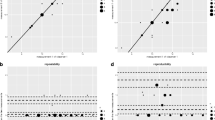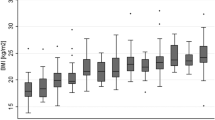Abstract
Forensic age assessments are crucial in the evaluation of criminal responsibility and preventing false age claims. Of all the methods available, the Greulich and Pyle (GP) atlas is most commonly used for age estimation purposes. Therefore, the current study sought to analyze the reliability and applicability of the GP standard and, additionally, to determine any possible association between the socioeconomic status (SES), food habits, and estimated skeletal maturity in the North Indian population. The study included 627 (334 males and 293 females) healthy children up to 19 years of age with varying SES and food habits. The skeletal age (SA) was estimated by three different evaluators using the GP atlas. The chronological mean age (CA) and SA were compared in different age cohorts. A paired t-test and a Pearson chi-square test were applied to show the difference between CA and estimated SA and the association of skeletal maturity with SES and food habits. The estimated skeletal age in males was retarded by 0.142 years or 1.72 months (p ≤ 0.05), whereas in females, it was retarded by 0.259 years or 3.12 months (p ≤ 0.05). In males, the GP method has significantly underestimated SA in age cohorts 3–4, 4–5, 6–7, 7–8, 8–9, and 12–13, whereas it overestimated in 10–11 and 18–19 years. However, in females, the SA was significantly underestimated in age groups 10–11, 12–13, and 14–15, respectively. Estimated skeletal maturity had no significant association with SES and food habits. The current study concludes that the GP atlas may not be applicable to North India’s population. The observed difference in assessed skeletal maturity may be due to geographical region, genetics, hormonal effects, etc., which require further investigation. Hence, population-specific standards are necessary to determine the bone age of Indian children accurately.





Similar content being viewed by others
Data availability
The datasets generated and/or analyzed during the current study are available from the corresponding author on reasonable request.
References
Aggrawal A. APC essentials of forensic medicine and toxicology, New Delhi. 2014;91–5.
Büken B, Şafak SS, Büken E, Mayda AS. Is the assessment of bone age by the Greulich-Pyle method reliable at forensic age estimation for Turkish children? Forensic Sci Int. 2007;173(2):146e53.
Scheming A, Reisinger W, Loreck D, Vendura K, Markus W, Geserick G. Effects of ethnicity on skeletal maturation: consequences for forensic age estimations. Int J Legal Med. 2000;113:253e8.
Greulich WW, Pyle SI. Radiograph atlas of skeletal development of the hand and wrist. 2nd ed. Stanford, California, USA: Stanford University Press. 1959.
Tanner JM, Whitehouse RH, Cameron N, Marshall WA, Healy MJ, Goldstein H. Assessment of skeletal maturity and prediction of adult height. (TW 2 method). London: Academic Press. 1983.
Tanner JM, Whitehouse RH, Cameron N, Marshall WA, Healy MJ, Goldstein NH. Assessment of skeletal maturity and prediction of adult height (TW3 method). 3rd ed. London: WB Saunders. 2001.
Bull RK, Edwards PD, Kemp PM, Fry S, Hughes IA. Bone age assessment: a large scale comparison of the Greulich and Pyle, and Tanner and Whitehouse (TW2) methods. Arch Dis Child. 1999;81(2):172e3.
Cunha E, Baccino E, Martrille L, Ramsthaler F, Prieto J, Schuliar Y, Lynnerup N, Cattaneo C. The problem of aging human remains and living individuals: a review. Forensic Sci Int. 2009;193(1–3):1–13.
Schmidt S, Koch B, Schulz R, Reisinger W, Schmeling A. Studies in use of the Greulich-Pyle skeletal age method to assess criminal liability. Legal Med. 2008;10(4):190e5.
Mora S, Boechat MI, Pietka E, Huang HK, Gilsanz V. Skeletal age determinations in children of European and African descent: applicability of the Greulich and Pyle standards. Pediatr Res. 2001;50:624e8.
Mansourvar M, Raj RG, Ismail MA, Kareem SA, Shanmugam S, Wahid Sh, et al. Automated web based system for bone age assessment using histogram technique. Malays J Comput Sci. 2012;25(3):107.
Kumar G, Dash P, Patnaik J, Pany G. Socio-economic status scale-modified Kuppuswamy scale for the year 2022. Int J Community Dent. 2022;10(1):1–6.
Van Rijn RR, Lequin MH, Robben SG, Hop WC, van Kuijk C. Is the Greulich and Pyle atlas still valid for Dutch Caucasian children today? Pediatr Radiol. 2001;31:748–52.
Chiang KH, Chou AS, Yen PS, Ling CM, Lin CC, Lee CC, et al. The reliability of using Greulich – Pyle method to determine children’s bone age in Taiwan. Tzu Chi Med J. 2005;17:417–20.
Cantekin K, Celikoglu M, Miloglu O, Dane A, Erdem A. Bone age assessment: the applicability of the Greulich-Pyle method in Eastern Turkish children. J Forensic Sci. 2012;57:679–82.
Garamendi PM, Landa MI, Ballesteros J, Solano MA. Reliability of the methods applied to assess age minority in living subjects around 18 years old. A survey on a Moroccan origin population. Forensic Sci Int. 2005;154:3–12.
Cole AJ, Webb L, Cole TJ. Bone age estimation: a comparison of methods. Br J Radiol. 1988;61:683–6.
Groell R, Lindbichler F, Riepl T, Gherra L, Roposch A, Fotter R. The reliability of bone age determination in central European children using the Greulich and Pyle method. Br J Radiol. 1999;72:461–4.
Schmeling A, Schulz R, Danner B, Rösing FW. The impact of economic progress and modernization in medicine on the ossification of hand and wrist. Int J Legal Med. 2006;120:121–6.
Zhang A, Sayre JW, Vachon L, Liu BJ, Huang HK. Racial differences in growth patterns of children assessed on the basis of bone age. Radiology. 2009;250:228–35.
Calfee RP, Sutter M, Steffen JA, Goldfarb CA. Skeletal and chronological ages in American adolescents: current findings in skeletal maturation. J Child Orthop. 2010;4:467–70.
Schmidt S, Koch B, Schulz R, Reisinger W, Schmeling A. Studies in use of the Greulich-Pyle skeletal age method to assess criminal liability. Leg Med. 2008;10(4):190–5.
Patil ST, Parchand MP, Meshram MM, Kamdi NY. Applicability of Greulich and Pyle skeletal age standards to Indian children. Forensic Sci Int. 2012;216(1):200–e1.
Zabet D, Rérolle C, Pucheux J, Telmon N, Saint-Martin P. Can the Greulich and Pyle method be used on French contemporary individuals? Int J Legal Med. 2015;129(1):171–7.
Levine E. Contribution of the carpal bones and epiphyseal centres of the hand to the assessment of skeletal maturity. Hum Biol. 1972;44(3):317e27.
Mohammed RB, Rao DS, Goud AS, Sailaja S, Thetay AAR, Gopalakrishnan M. Is Greulich and Pyle standards of skeletal maturation applicable for age estimation in South Indian Andhra children? J Pharm Bioallied Sci. 2015;7(3):218–25.
Gungor OE, Celikoglu M, Kale B, Gungor AY, Sari Z. The reliability of the Greulich and Pyle atlas when applied to a Southern Turkish population. Eur J Dent. 2015;9(2):251–4.
Alshamrani K, Offiah AC. Applicability of two commonly used bone age assessment methods to twenty-first century UK children. Eur Radiol. 2020;30(1):504–13.
Suri S, Prasad C, Tompson B, Lou W. Longitudinal comparison of skeletal age determined by the Greulich and Pyle method and chronologic age in normally growing children, and clinical interpretations for orthodontics. Am J Orthod Dentofac Orthop [Internet]. 2013;143(1):50–60.
Loder RT, Estle DT, Morrison K, Eggleston D, Fish DN, Lou Greenfield M, Guire KE. Applicability of the Greulich and Pyle skeletal age standards to black and white children of today. Arch Pediatr Adolesc Med. 1993;147(12):1329.
Ontell F, Ivanovic M, Ablin DS, Barlow TW. Bone age in children of diverse ethnicity. Am J Roentgenol. 1996;167:1395e8.
Pashkova VI, Burov SA. O vozmozhnosti ispol’zovaniia edinykh pokazateleĭ okosteneniia skeleta dlia sudebno-meditsinskoĭ ékspertizy opredeleniia vozrasta deteĭ i podrostkov, prozhivaiushchikh na vseĭ territorii SSSR [Possibility of using standard indices of skeletal ossification for the forensic medical expertise of determining the age of children and adolescents living throughout the whole territory of the USSR]. Sud Med Ekspert. 1980;23(3):22–5.
Roche AF, Roberts J, Hamill PV. Skeletal maturity of children 6–11 years: racial, geographic area, and socioeconomic differentials. United States Vital Health Stat. 1975;11(149):1–81.
Roche AF, Roberts J, Hamill PV. Skeletal maturity of youths 12–17 years racial, geographic area, and socioeconomic differentials, United States, 1966–1970. Vital Health Stat. 1978;11(167):1–98.
Sutow WW. Skeletal maturation in healthy Japanese children, 6 to 19 years of age. Comparison with skeletal maturation in American children. Hiroshima J Med Sci. 1953;2:181–93.
Greulich WW. A comparison of the physical growth and development of American-born and native Japanese children. Am J Phys Anthropol. 1957;15(4):489–515. https://doi.org/10.1002/ajpa.1330150403.
Schmeling A, Reisinger W, Loreck D, Vendura K, Markus W, Geserick G. Effects of ethnicity on skeletal maturation: consequences for forensic age estimations. Int J Legal Med. 2000;113(5):253–8. https://doi.org/10.1007/s004149900102.
Schmeling A, Reisinger W, Geserick G, Olze A. Age estimation of unaccompanied minors. Part I. General considerations. Forensic Sci Int. 2006;159(Suppl 1):S61–4. https://doi.org/10.1016/j.forsciint.2006.02.017.
Marshall WA, Tanner JM. Variations in pattern of pubertal changes in girls. Arch Dis Child. 1969;44:291–303.
Marshall WA, Tanner JM. Variations in pattern of pubertal changes in boys. Arch Dis Child. 1970;45:13–23.
Fleshman K. Bone age determination in a paediatric population as an indicator of nutritional status. Trop Doct. 2000;30:16–8.
Jahari AB, Haas J, Husaini MA, Pollitt E. Effects of an energy and micronutrient supplement on skeletal maturation in undernourished children in Indonesia. Eur J Clin Nutr. 2000;54(Suppl 2):S74–9.
Author information
Authors and Affiliations
Contributions
Author 1 made a significant contribution in acquisition of data, analysis, interpretation, and writing of manuscript. Author 2 made a significant contribution in data analysis and interpretation. Author 3 made a significant contribution in data analysis and interpretation and critically reviewed the article. Author 4 has substantially revised or critically reviewed the article. Author 5 has substantially revised or critically reviewed the article. Author 6 drafted the work or revised it critically for important intellectual content. Author 7 made a significant contribution in statistical analysis of data. Author 8 made a significant contribution in conception, study design, and data analysis of the work.
Corresponding author
Ethics declarations
Ethics approval
The questionnaire and methodology for this study were approved by the Human Research Ethics Committee of the Institute of Medical Science, Banaras Hindu University (ethics approval number: Dean/2018/EC/930).
Consent to participate
Informed consent was obtained from all individual participants/or from legal guardian included in the study.
Competing interests
The authors declare no competing interests.
Additional information
Publisher's Note
Springer Nature remains neutral with regard to jurisdictional claims in published maps and institutional affiliations.
Rights and permissions
Springer Nature or its licensor (e.g. a society or other partner) holds exclusive rights to this article under a publishing agreement with the author(s) or other rightsholder(s); author self-archiving of the accepted manuscript version of this article is solely governed by the terms of such publishing agreement and applicable law.
About this article
Cite this article
Tiwari, P.K., Nayak, A.K., Verma, A. et al. Greulich and Pyle atlas: a non-reliable skeletal maturity assessment method in the North Indian population. Forensic Sci Med Pathol 20, 106–116 (2024). https://doi.org/10.1007/s12024-023-00607-4
Accepted:
Published:
Issue Date:
DOI: https://doi.org/10.1007/s12024-023-00607-4




